Posted on 02/24/2024 5:59:01 AM PST by SpeedyInTexas
This list only includes destroyed vehicles and equipment of which photo or videographic evidence is available. Therefore, the amount of equipment destroyed is significantly higher than recorded here. Loitering munitions, drones used as unmanned bait, civilian vehicles and derelict equipment are not included in this list. All possible effort has gone into avoiding duplicate entries and discerning the status of equipment between captured or abandoned. Many of the entries listed as 'abandoned' will likely end up captured or destroyed. Similarly, some of the captured equipment might be destroyed if it can't be recovered. When a vehicle is captured and then lost in service with its new owners, it is only added as a loss of the original operator to avoid double listings. When the origin of a piece of equipment can't be established, it's not included in the list. The Soviet flag is used when the equipment in question was produced prior to 1991. This list is constantly updated as additional footage becomes available.
(Excerpt) Read more at oryxspioenkop.com ...
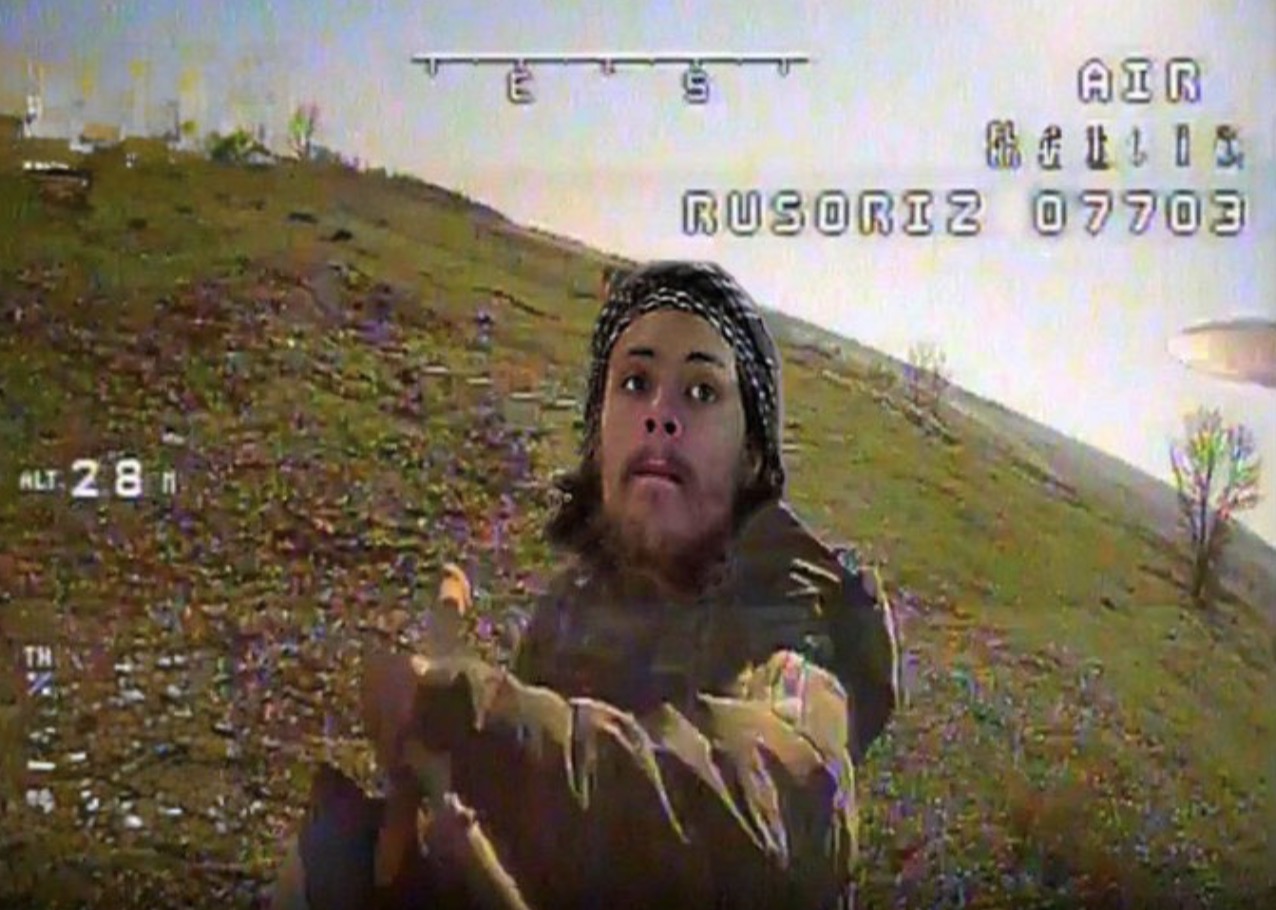
There was a champion woman athlete who was tried and impressioned by Russia a few years ago who certainly felt like Russia considered her an American enemy. She was sentenced for holding a small amount of pot for personal medicinal type use. Fortunately she was part of a prisoner exchange. Unfortunately the man the Russians got back was a notorious arms dealer.
There was a champion woman athlete who was tried and impressioned by Russia a few years ago who certainly felt like Russia considered her an American enemy. She was sentenced for holding a small amount of pot for personal medicinal type use. Fortunately she was part of a prisoner exchange. Unfortunately the man the Russians got back was a notorious arms dealer.
Britteny Griney was a ghetto drug dealer who since her release thinks she has become a man. Here she is with her wife.
Without a doubt you are the biggest lefty on this forum, and it makes complete sense you support Biden's war
North Korea to deploy 25K more troops to fight for Russia.
https://freerepublic.com/focus/f-news/4326601/posts
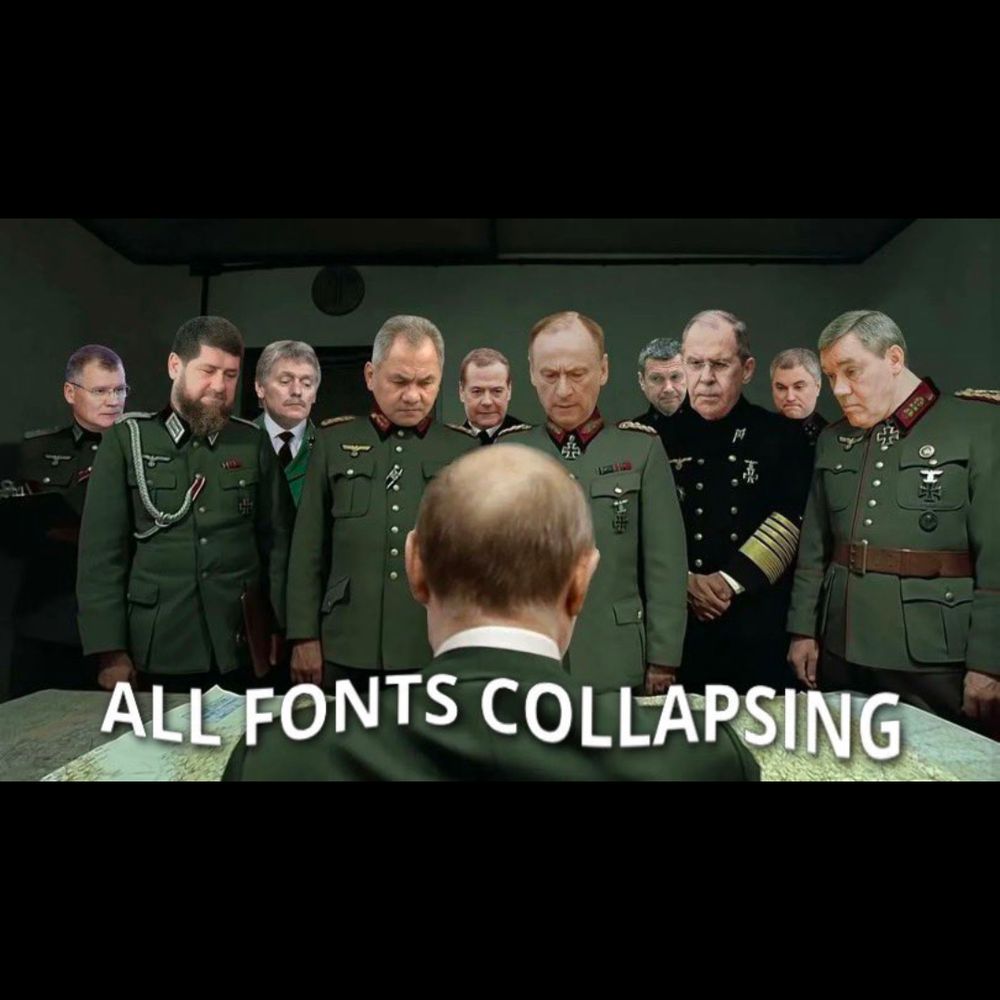
The United States paused weapons supplies to Ukraine, including critical air defense interceptors, artillery shells, missiles, and rockets. Western media outlets reported that sources stated on July 2 that the US pause on weapons supplies to Ukraine will affect dozens of PAC-3 interceptors for Patriot air defense systems, dozens of Stinger man-portable air defense systems, thousands of 155mm high explosive howitzer munitions, over 100 Hellfire air-to-ground missiles, over 250 Guided Multiple Launch Rocket System (GMLRS) rockets, dozens of grenade launchers, and dozens of AIM air-to-air missiles.[1] Familiar sources told Politico on July 1 that the United States decided in early June 2025 to withhold some of the aid that the United States promised Ukraine under the Biden administration but that the decision is only now taking effect.[2] Politico reported that the halted weapons come from two different streams of Biden administration-era support — weapons from drawdowns of current US stockpiles that the US Department of Defense (DoD) received money to replenish, and the Ukraine Security Assistance Initiative, in which the United States funds the purchase of weapons for Ukraine from US defense firms. White House Deputy Press Secretary Anna Kelly stated on July 1 that US authorities made the decision following a DoD review of US military support to states around the world.[3] Six defense officials, congressional officials, and other sources told NBC that the Pentagon ordered the pause after a review of US munitions stockpiles.[4] NBC's defense and congressional sources stated that the United States could hold up the weapons flow to Ukraine until the assessment of US stockpiles is complete but that the United States could extend the pause of military assistance to Ukraine even longer if the weapons are in short supply or if the United States needs to supply them to other parts of the world.
The Ukrainian Ministry of Foreign Affairs (MFA) stated on July 2 that continued deliveries of previously allocated US defense packages are critically important, particularly in order to strengthen Ukraine's air defense.[5] The Ukrainian MFA emphasized that any delay in supporting Ukraine's defense capabilities will encourage Russia to continue its war — and not seek peace. The Ukrainian MFA stated that US-Ukrainian consultations about defense supplies are ongoing at all levels and that Ukraine will speak with the United States about finding mutually beneficial solutions to strengthen Ukraine's defense capabilities.
The decision to suspend military aid to Ukraine will likely force Ukrainian forces to continue to husband materiel, although the exact timing of the planned deliveries that the United States paused remains unclear at this time. The Ukrainian Ministry of Defense (MoD) stated that Ukraine had not received any official notifications about any suspension or revision to the delivery schedules of the agreed US military aid prior to the US announcement.[6] The New York Times (NYT) reported that US officials stated that the United States had not scheduled to ship the affected munitions to Ukraine for several months, but the Wall Street Journal (WSJ) reported that US weapons shipments already in Poland were halted as of July 1.[7] A Trump administration official told Politico that the administration had not requested any further aid but that there is enough aid left over from the Biden administration to last Ukraine “several more months.”[8] The deputy commander of a Ukrainian battalion told the Washington Post in an article published on July 2, however, that Ukrainian forces already have to concentrate on holding positions and conserving resources rather than advancing.[9] Ukrainian forces have had to husband critical materiel, including air defense interceptors, GMLRS rockets, and artillery shells, during previous suspensions of US aid. Ukraine's European partners are increasing their efforts to provide Ukraine with military assistance and the Ukrainian defense industrial base (DIB) continues its efforts to become self-sufficient, but only the United States can provide certain weapons systems at scale and quickly.[10] Ukrainian forces very likely will have to conserve materiel again should the United States continue to suspend weapons deliveries.
The suspension of US aid to Ukraine will likely accelerate Russian gains on the battlefield, as previous US aid suspensions have in the past. Delays in US military aid in Fall 2023 and Winter-Spring 2024 set conditions for Russian forces to make more accelerated battlefield gains than Russian forces had previously been able to make.[11] Russian forces significantly intensified offensive operations near Avdiivka, Donetsk Oblast in mid-January 2024 and concentrated significant manpower and materiel to their effort to seize the settlement in mid-February 2024 amid the protracted debate in the US (from October 2023 until April 2024) about passing supplemental aid for Ukraine. Ukrainian forces also faced significant artillery constraints during the Russian offensive against Avdiivka, allowing Russian forces to attack under less pressure from Ukrainian counterbattery fire. Russian forces sustained a high tempo of offensive operations after seizing Avdiivka in order to push as far west as possible, and Russian forces subsequently launched offensive operations in Spring 2024 intended to seize Pokrovsk when the suspension of US assistance was still greatly constraining Ukrainian materiel supplies.[12] ISW assesses that Russian forces advanced roughly three kilometers per day between the suspension of US aid to Ukraine on December 6, 2023 and the resumption of aid on April 24, 2024, much of which was in Donetsk Oblast — as compared to the six months prior to the December 2023 aid suspension when Russian forces actually lost a total of roughly 203 square kilometers at a rate of 1.1 square kilometers lost per day (due to Ukraine's gains during the 2023 counteroffensive, which was enabled by the US and other allies surging military aid to Ukraine).
The suspension of US aid to Ukraine will reinforce Russian President Vladimir Putin's theory of victory that posits that Russia can win the war of attrition by making slow, creeping advances and outlasting Western support for Ukraine. Putin articulated a theory of victory in June 2024 — and has emphasized this same theory of victory since — that assumes that Russian forces will be able to continue gradual, creeping advances indefinitely and win a war of attrition against Ukrainian forces.[16] Putin's theory assumes that Russia will be able to outlast pledged Western security assistance and that Ukraine will not acquire and sustain the manpower and materiel needed to prevent these gradual Russian gains or to contest the initiative and conduct counteroffensive operations to liberate Ukrainian territory. The latest US suspension of aid will strengthen Putin's belief that time is on Russia's side and his commitment to delaying negotiations toward a peace settlement and protracting the war.
Russia remains unlikely to make operational-level breakthroughs in the near future. Future Russian gains — even relatively accelerated advances following the suspension of US aid — will likely remain gradual and creeping and result in disproportionally high losses as Russian forces still have not restored operational maneuver to the increasingly transparent battlefield. ISW has observed geolocated evidence to assess that Russian forces gained roughly 498 square kilometers in May 2025 and roughly 466 square kilometers in June 2025, and Russian gains in January to April 2025 ranged from roughly 175 to 590 square kilometers per month. These Russian gains are remarkably smaller than the 1,265 square kilometers per day that ISW assesses Russian forces were gaining at the start of Russia's full-scale invasion in March 2022.
Russia appears, however, to be preparing to undertake likely months- and years-long offensive campaigns — demonstrating the Russian military command's acceptance of continued slow, gradual advances and Putin's belief in his theory of victory. The Russian military command has recently prioritized efforts to attack Ukraine's fortress belt in Donetsk Oblast, a campaign that is likely to take Russia years to achieve at Russian forces’ current tempo.[17] Russian forces may not be able to achieve these objectives by themselves. CNN reported on July 2 that a Ukrainian intelligence assessment stated that North Korea will likely send an additional 25,000 to 30,000 soldiers to Russia in the coming months and that there is a “great possibility” that the North Korean forces will augment Russian forces in Ukraine, including “during large-scale offensive operations.”[18]
Kremlin officials are responding to the US military aid suspension by publicly flouting Putin's theory of military victory as successful — in direct opposition to US President Donald Trump's stated goal of bringing Russia to the negotiating table and achieving a lasting and just peace. Kremlin Spokesperson Dmitry Peskov stated on July 2 in response to the suspension of US military aid that the “fewer weapons that are supplied to Ukraine, the closer the end of the [Russian invasion of Ukraine] is.”[19] Russian Direct Investment Fund (RDIF) CEO Kirill Dmitriev, who has been heavily involved in diplomatic and rhetorical efforts vis-à-vis Ukraine and the United States, stated that the suspension “raises questions about the West's ability to continue supporting Ukraine.”[20] Russian State Duma Defense Committee Deputy Chairperson Dmitry Zhuravlev suggested that the US military aid suspension will degrade Ukraine's ability to “hold out” against Russian offensive operations and claimed that the United States will not be able to “hide” any future arms deliveries to Ukraine from Russia.[21] These Russian statements underscore how the Kremlin perceives Putin's theory of victory as it relates to Western — particularly American — military assistance to Ukraine and flout the Kremlin's goal of coercing the United States and other Western states into ceasing military assistance to Ukraine.[22] The Kremlin is capitalizing on the US aid suspension to intensify its messaging that Europe should also cease weapons supplies to Ukraine. Putin had a phone call with French President Emmanuel Macron on July 2, the first Putin-Macron call in nearly three years, and used the call to reiterate boilerplate Kremlin narratives aimed at discouraging further Western military assistance to Ukraine.[23] Russian Ministry of Foreign Affairs (MFA) Spokesperson Maria Zakharova also criticized continued European military assistance to Ukraine.[24] The Kremlin's messaging about the suspension of US military aid to Ukraine is yet another indicator that Russia remains committed to achieving its war goals by force and is uninterested in meaningful peace negotiations to end the war.[25] These senior Russian officials’ statements indicate that suspending US military aid to Ukraine very likely will not compel Russia to conduct meaningful negotiations with Ukraine as President Trump desires, but rather embolden Moscow to continue protracting Russia's war.
The Kremlin is also using the US aid suspension as a basis to continue rhetorical attacks against European defensive efforts that are in line with Trump's initiative for Europe to shoulder more of the burden for collective defense. Russian Deputy Foreign Minister Alexander Grushko claimed on July 2 that the European Union's (EU) increased defense spending and development of its DIB show that the EU is becoming an “aggressive military bloc” that Russia will have to defend itself against.[26] Grushko claimed that the EU carries out NATO's tasks and that the two organizations are deeply linked. Zakharova also claimed that the EU is turning into a military bloc and is “pumping” Ukraine with weapons.[27] Russian Ambassador to Norway Nikolay Korchunov told the Russian state news agency RIA Novosti in an interview published on June 30 that Norway is trying to benefit from the “militarization” of Europe and is “pumping up” the Ukrainian military.[28] Korchunov claimed that Norway is intensifying NATO military exercises on Norwegian territory near the Russian border and that Norway's militarization will increase tension and escalation risks in the Arctic and destabilize European security. Russian officials continue to mischaracterize increased NATO defense spending that is aimed at deterring war in Europe by building defense capabilities in response to Russia's ongoing efforts to restructure and expand Russia's military capabilities.[29] The Kremlin's efforts to deter Western military assistance to Ukraine and European rearmament efforts are part of its wider cognitive warfare efforts that aim to shape Western decision-making and erode the West's will to act against Russian interests and resist Russia.[30]
The US decision to suspend military aid to Ukraine will particularly degrade Ukraine's ability to defend against Russia's enhanced long-range missile and drone strike capabilities that have inflicted significant civilian casualties — in sharp contrast to President Trump's stated objective of stopping civilian casualties in Ukraine. US provisions of Patriot air defense systems and interceptors have been critical for Ukraine's ability to defend against Russia's missile strikes, particularly those with ballistic missiles.[31] Russia's long-range strikes have increasingly targeted densely populated cities far from the frontline.[32] Russia has recently prioritized expanding its long-range drone and missile production and stockpiling its ballistic missiles, enabling Russia to conduct larger, more effective combined missile and drone strike series against Ukraine.[33] Russia has notably conducted five of its largest combined strikes against Ukraine throughout the full-scale invasion between March and June 2025 and is launching an increasingly high number of Shahed and decoy drones that overwhelm Ukrainian air defenses, allowing more Russian missiles to hit their targets.[34] Russia has also recently adapted its strike tactics to inflict maximum damage to civilians, including by deploying cluster munitions with delayed detonations, and Shahed drones equipped with capsules of chemical weapons and conducting “double tap” strikes that maximize casualties of civilian first responders.[35] Russia will very likely continue to increase the size of its combined strikes against Ukraine as Russia remains committed to accelerating its missile and drone production. The US suspension of critical Patriot interceptor supplies to Ukraine will likely impact Ukraine's ability to protect its critical, industrial, and civilian infrastructure. Russian forces exploited pauses in US military aid to Ukraine in late 2023 and early 2024 to conduct large-scale combined strikes designed to exhaust Ukraine's degraded air defense umbrella that was suffering from the lack of Western aid.[36] A dwindling supply of Patriot interceptors will force Ukraine to continue to make difficult defense prioritization decisions.
https://www.understandingwar.org/backgrounder/russian-offensive-campaign-assessment-july-2-2025

Three important points about Azerbaijan
The aggravation of diplomatic dialogue with Azerbaijan did not surprise anyone. Although the speed of deterioration of relations took many by surprise. What is important to understand about the situation?
Firstly, Azerbaijan tried to publicly maintain neutrality from the beginning of the NWO [invasion of Ukraine], and Aliyev himself was one of the few leaders who maintained dialogue with both Moscow and Kiev. The crash of the AZAL Baku-Grozny plane was extremely untimely. Aliyev demanded a public apology, compensation and punishment of the perpetrators (in particular, Ramzan Kadyrov). Moscow decided not to follow Baku's lead.
Secondly, against the backdrop of the scandal, Azerbaijani media leaked an explanatory note from Russian captain Dmitry Paladichuk. This document was given to Azerbaijan by Russia as part of the investigation. We will not go into detail, but the key point is that the military knew that the “intended target” was not a drone, but probably an airplane. But they opened fire and damaged the plane. Moreover, the note says that they shot twice. It is obvious that this card has long been in the hands of the Azerbaijani side, but they decided to pull out the trump card only now.
Thirdly, Azerbaijan is not acting on its own. All actions have been coordinated with Turkey. Erdogan wants to act as a mediator, which will emphasize his role in the region, will allow to note the growing role of Azerbaijan in “ensuring security in the Caucasus”. The Kremlin is not yet ready to include Ankara in the negotiation process, although interlocutors in power admit that the situation is difficult. They promise to deal with the activities of national criminal organizations and with individual representatives of Azerbaijan, who “feel very at ease in Russia”. The deportation of Azerbaijanis is expected, which may begin next week. If the crisis continues.
https://t.me/kremlin_secrets/5872
3JUL2025: Official Baku demanded an investigation into the crash of the Azerbaijan Airlines plane and compensation for the victims after Moscow expressed protest over the actions of Azerbaijani security forces against Russian citizens.
https://www.kavkaz-uzel.eu/articles/412746
© Кавказский Узел
Finally, something that Azerbaijan and Armenia can agree on - that Russia can’t be trusted.
https://t.me/rucriminalinfo/2835
Billionaire on trial in Azerbaijan who risks being left behind by peace deal
Everything changed for Ruben Vardanyan in September 2022 when he decided to move to Nagorno-Karabakh, a mountainous region that was historically populated by ethnic Armenians but part of Soviet Azerbaijan.
Vardanyan renounced his Russian citizenship and became the de facto prime-minister of Nagorno-Karabakh, which Armenians call Artsakh. He used his name, contacts and the ability to speak fluent English to raise the awareness of the plight of Karabakh Armenians.
https://www.bbc.com/news/articles/c86jw1w0n5vo
Questions were raised about Vardanyan’s ability to abandon his Russian citizenship so fast. The process takes 6 to 12 months for average individuals, and you have to gather a lot of paperwork.[16] He has close ties to Vladimir Putin. In some Armenian circles, Vardanyan was accused of and criticized for supposedly suggesting that Armenia be subjected to the Russian Federation in much the same way as the autonomous republic of Tatarstan..
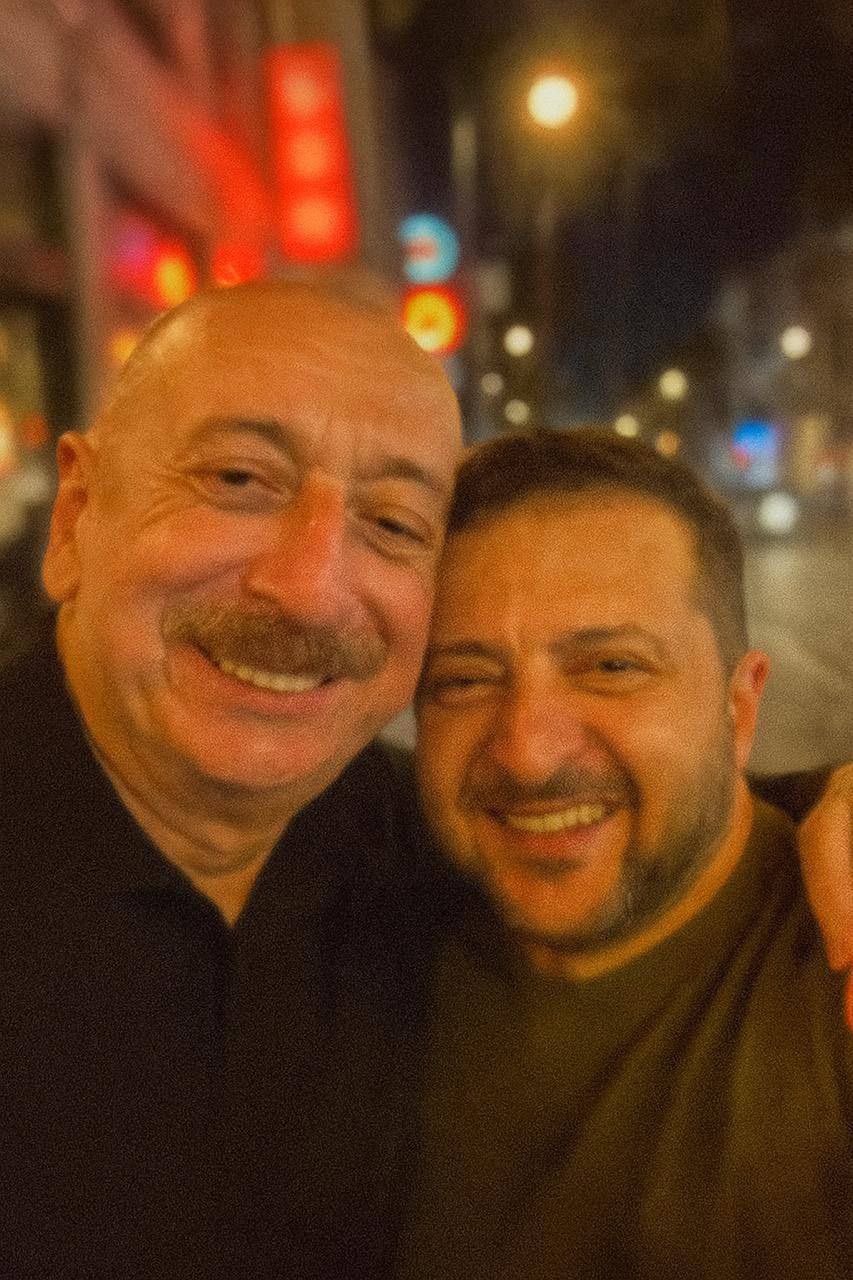
Every day, new verified videos prove the Russian Army is cracking:
Russian soldiers surrendering en masse, including in the Sumy region.
Units openly mutinying against their commanders.
Troops abandoning positions in a war they no longer believe they can win.
In this hard-hitting analysis, Jason Smart is joined by Chuck Pfarrer, former Assault Element Commander with Navy SEAL Team Six (Naval Special Warfare Development Group, DEVGRU) and acclaimed national security strategist. Together, they expose what the Kremlin wants hidden: how Ukraine's military strategy—precision HIMARS strikes, drone attacks, and mobile counteroffensives—is systematically dismantling Russia's conventional forces and blocking Moscow's hopes for a drawn-out war of attrition.
As Russia's economy collapses under runaway inflation, ruble devaluation, and defense production failures, Ukraine is escalating strikes on logistics hubs, fuel depots, and command centers—shattering Russian morale. Pfarrer and Smart break down these battlefield dynamics, showing how Ukraine is transforming the war's tempo to outpace and cripple a decaying Russian military machine.
https://www.youtube.com/watch?v=f7GQpNEei0U
15 min video
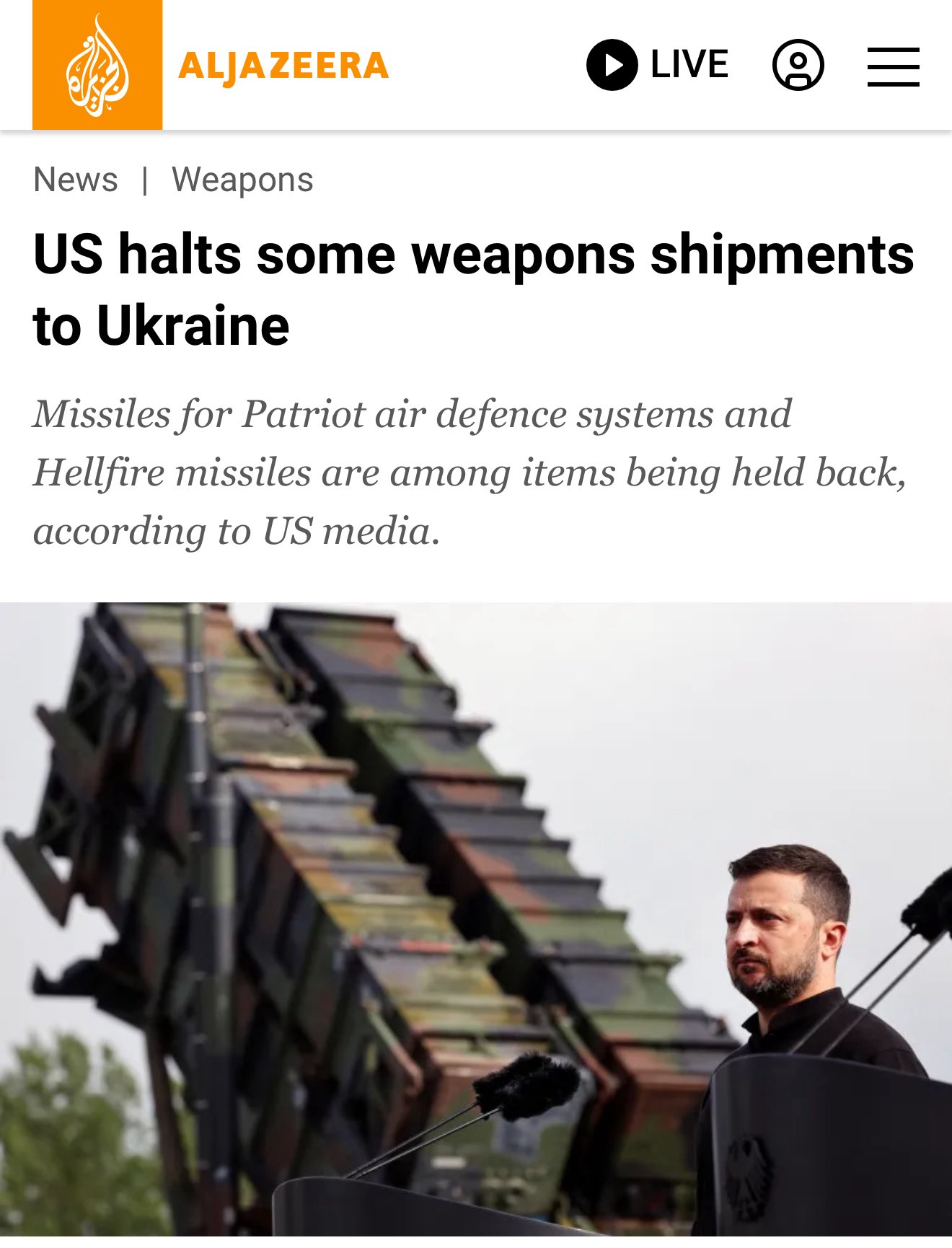
Another reason for total mobilization in Russia has been named
Philosopher Aleksandr Dugin believes that the reason and even the “obvious cause” for the total mobilization of several million people could be the death of Deputy Commander-in-Chief of the Navy Mikhail Gudkov in the Kursk region. “The military leader who died at the hands of the enemy showed the most striking example of the tragic but heroic future that awaits many Russians. He approached the enemy in order to inflict damage on him, and shed his blood in order to defeat the vile Kiev regime and its patrons. This is probably the best death for a military man, he immediately became a real saint. And he set an example for many Russians,” Aleksandr Gelyevich said in a conversation with us.
In his opinion, Gudkov showed that “to die for the Motherland is the highest honor.” “I think that after this many of our men will be inspired, they will want to join the army, beat the enemy, shed their blood in a holy war, become participants in the Third World War , which is inevitable, and go down in history. That is why I consider the death of such a high-ranking military leader a reason for total mobilization. When else to carry it out, if not now, when we see the feat of a real Russian Warrior before our eyes?” Dugin explained his position.
He continues to assert that carrying out total mobilization and replenishing the army by several million people is a matter of time. The military with whom we spoke on this matter are waiting for mobilization . But they do not think that it will be total.
Russian President Vladimir Putin rejected US President Donald Trump's call for a quick peace in Ukraine during a phone call with Trump on July 3.[1] Russian Presidential Aide Yuriy Ushakov claimed on July 3 that Trump once again raised the issue of a quick end to Russia's war in Ukraine and that Putin claimed that Russia continues its efforts for a negotiated end to the war. Ushakov claimed, however, that Putin reiterated that Russia “will achieve its goals” and “eliminat[e] the root causes” that led to the war and that “Russia will not back down from these goals,” essentially emphasizing that Russia will continue its war on its own terms. Ushakov claimed that Putin and Trump discussed the possibility of a third round of Ukrainian–Russian negotiations in Istanbul and agreed that peace negotiations will continue in a bilateral format at an unspecified date. Ushakov claimed that Putin and Trump did not discuss the recent US decision to halt military aid shipments to Ukraine but discussed bilateral economic projects, including in the energy and space spheres.
Putin's stated commitment to his goals in Ukraine, including eliminating the so-called “root causes” of the war directly contradicts his claim that Russia supports meaningful negotiations to end the war. Putin and other Kremlin officials have repeatedly referred to the need for any future peace settlement to eliminate the alleged “root causes” of the war to allude to Russia's unwavering demands for regime change in Ukraine, Ukrainian neutrality, and changes to NATO's foundational open-door policy.[2] ISW continues to assess that Russia remains uninterested in good-faith peace negotiations to end the war. Putin's statement that Russia will not back down from its goals further demonstrates Putin's willingness to prolong the war in Ukraine and achieve his goals through military means should Russia be unable to force Ukraine to capitulate through diplomatic means — in direct contrast to Trump's calls for a speedy end to the war. The Kremlin has continually indicated in recent weeks that there are no plans yet for a third round of bilateral negotiations in Istanbul, so it is unclear if or when bilateral Ukrainian–Russian negotiations will resume.[3] ISW continues to assess that Russia will likely leverage any future negotiations to try to extract concessions from Ukraine and the United States while Russian forces continue efforts to secure additional gains on the battlefield through creeping and highly attritional advances. Russia previously exploited peace talks with Ukraine in Istanbul to obfuscate its own uninterest in meaningful negotiations, and any future Ukrainian–Russian negotiations on anyone's terms but Kyiv’s are very unlikely to bring about Trump's desired expeditious end to the war and just and lasting peace.
Details about the recent US suspension of aid to Ukraine remain unclear. Journalists for National Public Radio (NPR) and the Economist stated on July 2 and 3 that the United States halted aid shipments to Ukraine in Poland that included 30 PAC-3 interceptors for Patriot air defense systems; 8,496 155mm high explosive howitzer munitions; 142 AGM-114 Hellfire air-to-ground missiles; 252 Guided Multiple Launch Rocket System (GMLRS) rockets; 25 missiles for Stinger man-portable air defense systems (MANPADS); 125 AT-4 grenade launchers; and 92 AIM air-to-air missiles.[4] The Economist reported on July 3 that the Pentagon turned around planes carrying air defense interceptors and other US military aid to Ukraine on June 30 and July 1, suspending deliveries.[5] US Department of State Spokesperson Tammy Bruce stated on July 3 that Trump has indicated his “remaining commitment” to US provisions of Patriot interceptors to Ukraine.[6] Bruce stated that the United States “hasn't paused” sending weapons to Ukraine but that the recent suspension is “one aspect, one situation, one event that has been changed.” Chief Pentagon Spokesperson Sean Parnell stated on July 2 that the US Department of Defense (DoD) “paused” weapons shipments to Ukraine to conduct a “capability review” to ensure that US military aid aligns with the DoD’s defense priorities while preserving US military readiness.[7] Parnell stated that DoD recommendations about military aid to Ukraine are consistent with US President Donald Trump's stated goal of ending the war in Ukraine.
A Ukrainian strike killed the deputy commander-in-chief of the Russian Navy in Kursk Oblast, and an unknown actor may have assassinated a high-ranking Russian Federal Security Service (FSB) official in Moscow City. The Russian Ministry of Defense (MoD) acknowledged on July 3 that Deputy Commander-in-Chief of the Russian Navy Major General Mikhail Gudkov died on July 2 during combat operations in the Kursk Oblast border area.[8] Gudkov previously served as commander of the 155th Naval Infantry Brigade (Pacific Fleet), and Russian President Vladimir Putin promoted him to deputy commander-in-chief of the Russian Navy in March 2025.[9] Primorsky Krai Governor Oleg Kozhemyako reported on July 3 that Captain Second Rank Nariman Shikhaliev died alongside Gudkov.[10] Gudkov’s obituary from the “Typhoon” All-Russian Organization of Naval Infantry stated that Ukrainian forces launched a missile strike against the command post of the 155th Naval Infantry Brigade near Korenevo, Kursk Oblast, on July 2, killing over 10 servicemembers, including Gudkov and several senior officers.[11] Ukrainian military observer Yuriy Butusov reported that the strike killed Gudkov’s deputy and 20 other Russian servicemembers.[12] Radio Svoboda stated that “unconfirmed official reports” suggest that a Ukrainian HIMARS strike killed Gudkov.[13] Telegram channel Nexta additionally claimed on July 3 that there are unconfirmed reports that Alexei Komkov, head of the FSB’s Fifth Directorate, which is officially tasked with overseeing operational information and international relations, died after a car exploded in central Moscow City.[14] ISW cannot confirm the death of Komkov or the actor responsible for the reported car explosion in Moscow City.
Ukraine's Western allies continue to provide military aid to Ukraine, but the United States remains the only Ukrainian partner that can provide certain critical weapons systems – especially air defenses — at scale and quickly. Ukrainian President Volodymyr Zelensky announced on July 3 that Ukraine signed a memorandum on a long-term strategic partnership with US autonomous system engineering company Swift Beat, agreeing to produce hundreds of thousands of interceptor drones in 2025 that are capable of shooting down Russian Shahed drones and to expand production further in 2026.[17] Ukrainian Defense Minister Rustem Umerov also announced on July 1 that Ukraine is launching a joint arms production program with its international Ramstein format partners to produce weapons for the Ukrainian military in Ukraine and abroad.[18] Swedish Defense Minister Pål Jonson stated on July 3 that Sweden is allocating an additional 1.5 billion Swedish kroner (roughly $156 million) to purchase over 10 new Archer artillery barrels, augment long-range strike and underwater capabilities, and support unspecified logistical support for Ukraine.[19] The Latvian Ministry of Defense (MoD) announced on July 2 that Belgium and Turkey joined the UK- and Latvian-led international drone coalition.[20] The Latvian MoD also announced on July 1 that it approved the transfer of 42 Patria armored personnel carriers (APCs) and other military equipment to Ukraine.[21] UK defense and security enterprise Prevail Partners announced on July 2 that it launched a joint partnership with Ukrainian drone manufacturer Skyeton International to increase production of long-range drones as part of efforts to supply drones to Ukraine and provide the UK with modern military equipment.[22] Unspecified German security forces told German media outlet Die Welt on July 1 that Germany signed a contract to finance the production of over 500 Antonov-196 (AN-196) ”Lyutyi” long-range drones for Ukraine.[23] ISW continues to assess that US aid to Ukraine, particularly Patriot air defense systems and interceptors, is critical to Ukraine's ability to protect its defense industrial base (DIB) and safeguard the capabilities it obtains from its partners in the face of long-range Russian strikes.[24] Such US-provided systems are required soh that Ukraine's DIB can grow to be largely self-sufficient and able to sustain Ukraine's materiel requirements with domestic production.
https://www.understandingwar.org/backgrounder/russian-offensive-campaign-assessment-july-3-2025
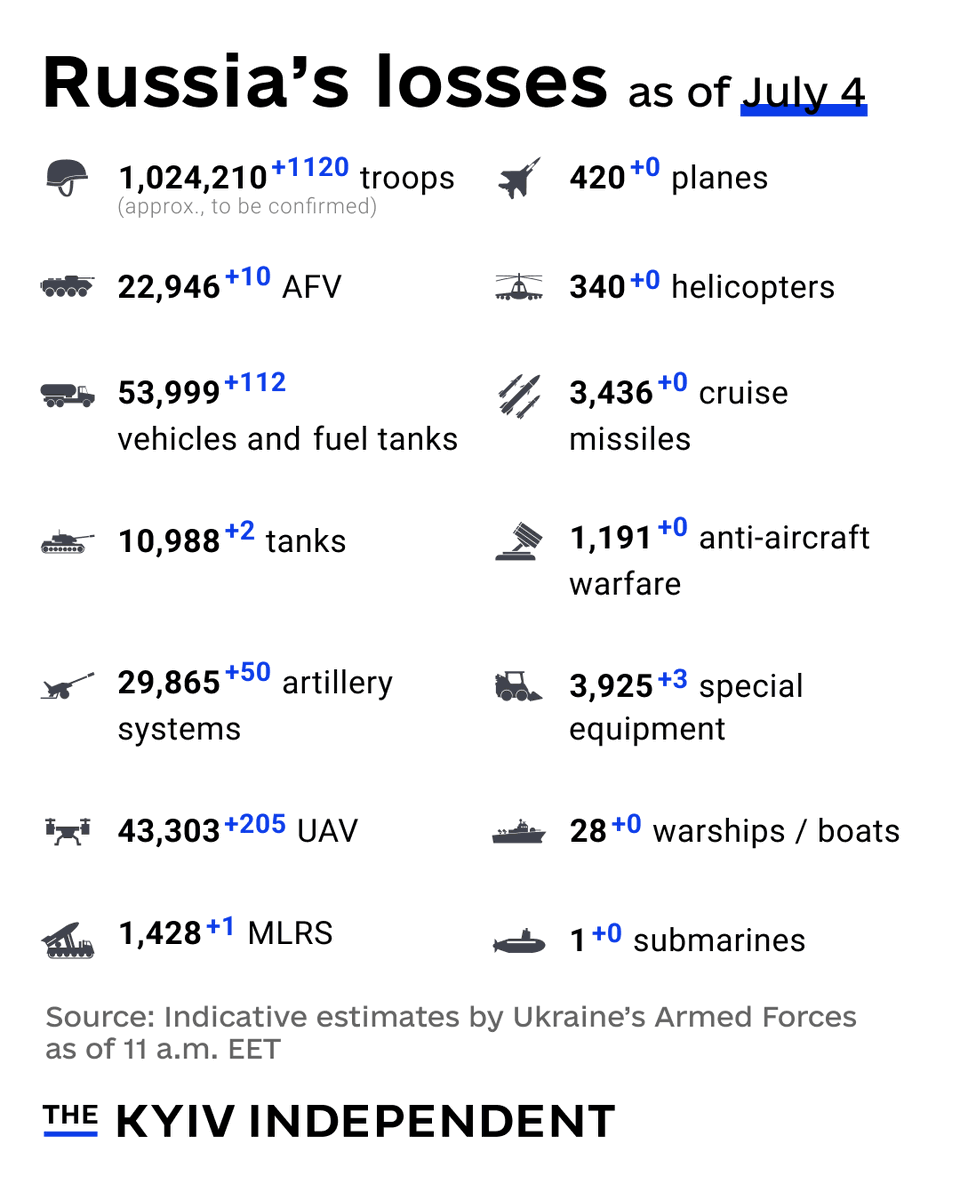
https://bsky.app/profile/euanmacdonald.bsky.social/post/3lt4jp3l3xc23
https://bsky.app/profile/euanmacdonald.bsky.social/post/3lt3ytmzivk2l
Disclaimer: Opinions posted on Free Republic are those of the individual posters and do not necessarily represent the opinion of Free Republic or its management. All materials posted herein are protected by copyright law and the exemption for fair use of copyrighted works.